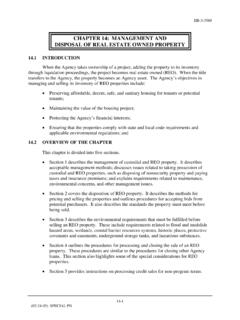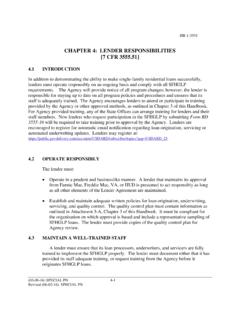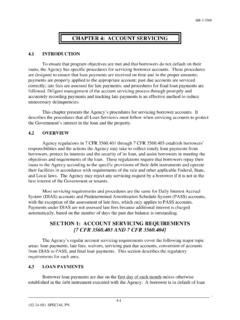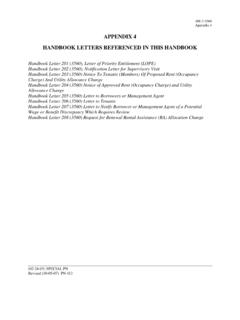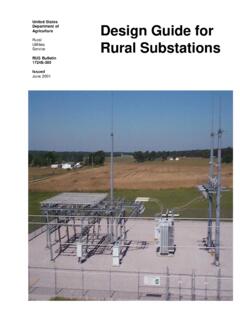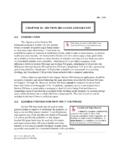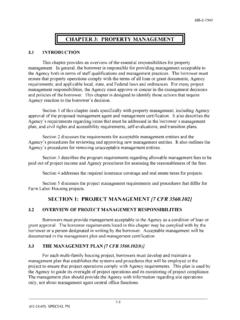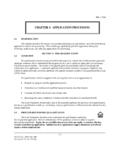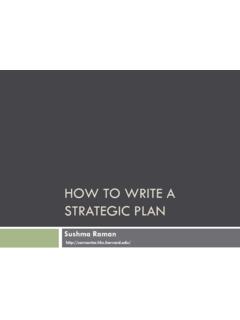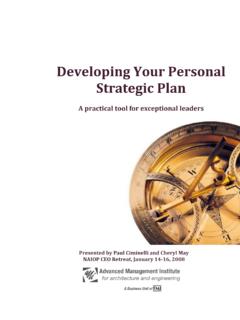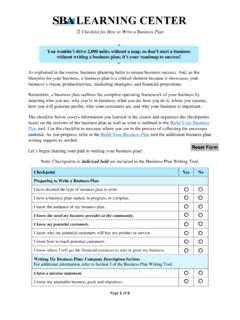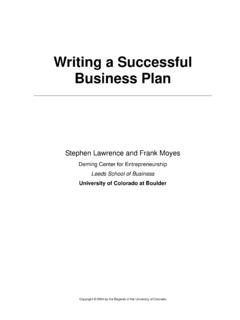Transcription of Strategic Planning Handbook for Cooperatives
1 Strategic Planning Handbook for Cooperatives Jerry C. Namken Galen W. Rapp USDAIRBS. This Handbook presents a method for facilitating the Strategic Planning process. Facilities, personnel, and equip- ment associated with the process are described. A description of brainstorming is given along with rules for conducting such sessions. The five phases of Strategic Planning are described in detail-agreeing to plan , gathering facts, evaluat- ing facts, defining the plan , and evaluating results. Hints for success are provided throughout. KeywoMs: Strategic , Planning , Cooperatives , Handbook . Cooperative Information Report 48. Issued October 1994. Reviewed and approved for reprinting July 1997. Price: Domestic-$ ; foreign-$5. If you don't know where you are going, any road will get you there.
2 -Wizard of Oz. This Handbook is an introduction to Strategic Planning for the board of directors and managers of small- to medium- . sized agricultural Cooperatives about to begin the Strategic Planning process. It is intended as a background reference guide to be read prior to beginning the Strategic Planning process. Cooperative directors maintain a long-term perspective of where the cooperative is headed. They are concerned with how the cooperative can better serve members' needs and what general changes may be necessary in organizational and operating policies. The manager is action and tactic oriented in running the day-to-day operations in response to the goals and objectives set by the board. A well prepared Strategic plan is the best management tool a board of directors can give its manager.
3 Strategic Planning is a skill. The longer participants use it, the more proficient they become in developing their skills. Contents The Strategic Planning Process .. 1. Facilities, Personnel, and Equipment .. 4. Facilitator .. 5. Recorder .. 5. Planning Committee .. 6. Hardware Needed .. 6. Brainstorming .. 6. Phase 1. Agreeing to Develop a Strategic plan ..10. Agreement .. 10. Ground Rules for Planning Sessions .. 11. Topics to be addressed in this phase are: .. 12. Phase 2. Fact Gathering .. 13. Visioning .. 13. Cooperative Environment .. 14. External Environment .. 15. External Evaluation Questions: .. 16. Internal Environment .. 16. Internal Evaluation Topics .. 17. ii Phase 3. Evaluating Alternatives .. 18. Mission Statement .. 19. Mission Statement Topics .. 20. SWOT Analysis.
4 21. SWOT Topics .. 21. Strategic Options .. 23. Strategic Options Topics .. 24. Phase 4. Defining the plan .. 25. Choosing a Direction .. 26. Goals .. 26. Goal Topics .. 27. Objectives .. 27. Objective Topics .. 27. Action Plans .. 27. Action plan Topics .. 28. Phase 5. Finishing the Job and Starting Over ..*..29. Definitions ..*..*..*.. 30. Strategic Planning Handbook for Cooperatives Jerry C. Namken Galen W. Rapp USDA/RDA-Cooperative Services THE Strategic Planning PROCESS. A line from The Wizard of Oz movie said, If you don't know where you are going, any road will get you there. While this might work for some, successful business operations are planned. A strategy is the use of assets though long-run Planning and development to ensure success. Strategic Planning is a step- by-step determination of where you are, where you want to go, how you wish to get there, when you want to arrive, who will do the work, and how much you are willing to pay.
5 Cooperative directors have the responsibility to originate and maintain a long-term perspective of where the cooperative is headed. They are concerned with how the cooperative can bet- ter serve members' needs and what general changes may be necessary in organizational and operational policies. The manager is action and tactic oriented in running the day- to-day operations in response to the goals and objectives set by the board. A well-thought-out strategy plan is the best man- agement tool that a board of directors can give its manager. Strategic Planning is long-term Planning . It differs from short term or annual budgeting. Annual budgeting with cash-flow projections is usually sufficient for 1 year. However, this kind of short-term Planning , on a year-to-year basis only, is akin to committing business suicide when factors in the business world change.
6 While long-term Strategic Planning doesn't guarantee success, it improves the odds of success. The Strategic Planning process is a formal and systematic endeavor to determine where the cooperative is and where it is going in the future. The Planning horizon is usually 3 to 10 years. Some groups plan 25 years into the future. In some cases it is appropriate to plan around a farm commodity cycle, such as the hog and cat- tle cycles, when they are related to the cooperative's business. Strategic Planning is goal oriented and focuses on specific measurable actions. It is based on available and factual infor- mation and assumptions regarding the future. It clarifies rela- tionships, promotes understanding of established objectives, and assigns specific responsibilities, tasks, and time schedules.
7 It includes orderly reviews of progress. Strategic Planning uses the cooperative's strengths to put it in the best possible position while change is occurring. It also devises steps to minimize the cooperative's weaknesses, or even better, devises steps that turn its weaknesses into strengths. Strategic Planning helps obtain the confidence of lenders and investors. It evaluates alternative actions. In short, Strategic Planning makes a cooperative proactive, instead of reactive. Figure 1 shows the phases of Strategic Planning . When put into regular, annual practice, Strategic Planning includes five different, but highly inter-related phases. Because each phase takes time to complete, they follow one another at different times, rather than being performed all at once in a single day The basic idea of Strategic Planning is to gather and present information on trends and forces affecting the cooperative.
8 The Planning group helps decide what are the cooperative's values and beliefs are and how it will conduct business. With 2. Figure 1 - Strategic Planning Phases Phase 1 Phase 2 Phase 3 Phase 4 Phase 5. Agreement Gather Facts Evaluate Define plan Finish \. Visioning Mission Statement \ rl Choose Direction Agree to External SWOT. plan Factors Internal Strategic Action Factors Options II. these belief statements in mind, an overall mission or purpose is developed. Goals are established. Measurable objectives are then developed for measuring progress. Activities are assigned to people and financial and time resources allocated. Terms of performance are set for evaluating progress. The plan is implemented and its effects are evaluated. Strategic Planning takes time and commitment.
9 It is not unusu- al to spend three or four days in the first three phases, gather- ing facts, producing a mission statement, and identifying strengths, weaknesses, opportunities, and threats (SWOT) to the cooperative. This is especially true if the Planning group is entering the Strategic Planning process for the first time. 3. (Subsequent Planning sessions in later years tend to be shorter, but more productive as Planning group members develop their skills and the cooperative begins to meet its goals.). Often, several alternatives will emerge from this first session that need to be investigated more fully before the pla nning group can decide which direction to take. Considerable time may be needed to do feasibility studies, cost-benefit compar- isons, or other financial, economic, or personnel evaluations.
10 At a second meeting, the results of theses studies are evaluat- ed and Planning continues. Several days may be needed to determine goals that will favorably position the cooperative, set the objectives for meeting those goals, and then make the decisions about the activities that will take place. Hints for Success: l Don't suggest or feel that outsiders know your business better than yourself. l Strategic Planning is a process that takes time. Start simple and build on a few ideas at first. Develop successes at the beginning of the Planning cycle that are measurable. Realize that it may take 5 or more years of Strategic Planning before a vision becomes a reality. l Don't try to revise or customize some other business' strate- gic plan . Facilities, Personnel and Equipment Use an informal meeting site away from the cooperative for the Strategic Planning sessions.
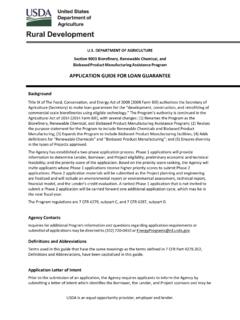
![CHAPTER 14: FUNDING [Official Agency Use Only]](/cache/preview/5/1/5/b/5/3/5/c/thumb-515b535cec62fd2bb25fbb788ef1c7a2.jpg)
